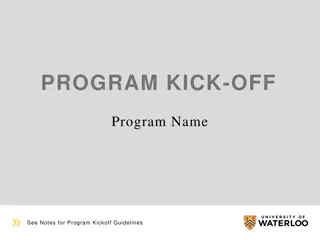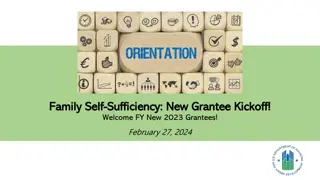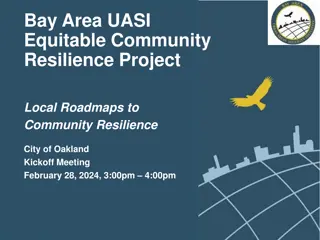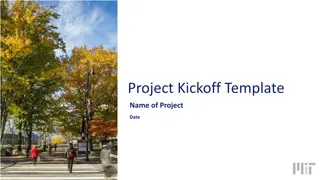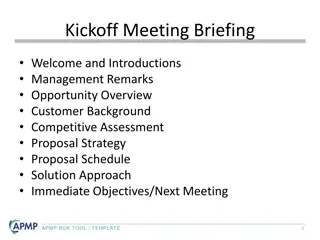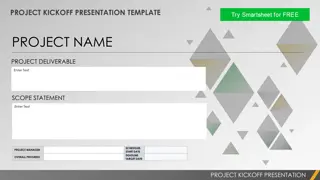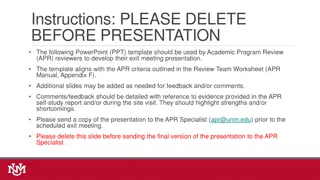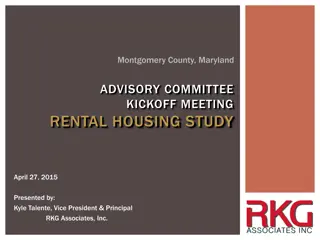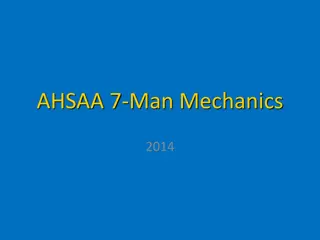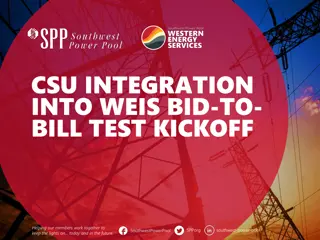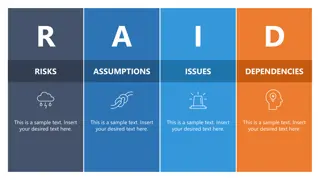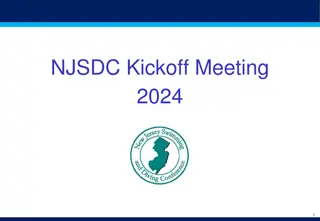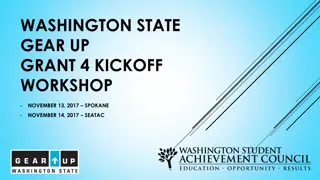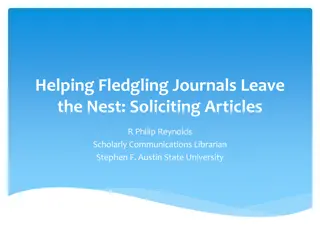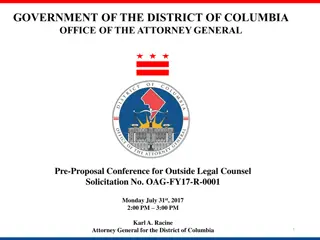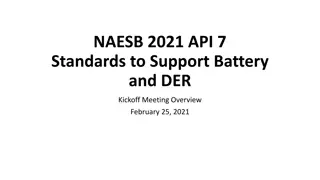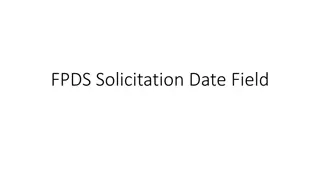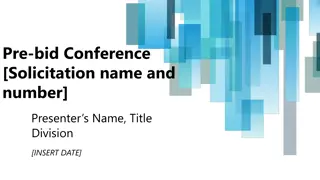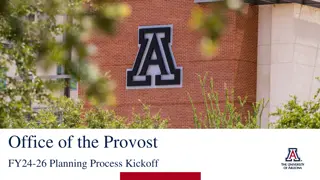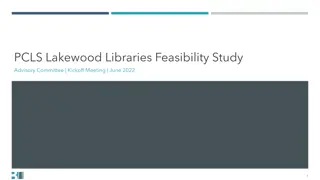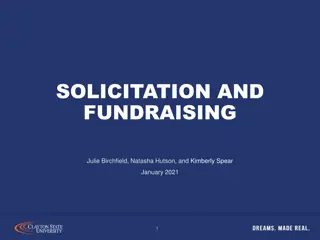Effective Solicitation Kickoff Meeting Template for Government Agencies
This slide deck template offers guidance on hosting a solicitation kickoff meeting, providing a structured approach to align with agency staff, streamline the procurement process, and enhance the quality of RFPs. The template includes suggested agenda items, instructions for understanding stakeholders' needs, and example slides for discussion, helping government entities conduct productive and efficient solicitation kickoff meetings.
Download Presentation

Please find below an Image/Link to download the presentation.
The content on the website is provided AS IS for your information and personal use only. It may not be sold, licensed, or shared on other websites without obtaining consent from the author. Download presentation by click this link. If you encounter any issues during the download, it is possible that the publisher has removed the file from their server.
E N D
Presentation Transcript
Solicitation Kickoff Meeting Template Slide Deck [Date] govlab.hks.harvard.edu
INSTRUCTIONS: Hosting a Solicitation Kickoff Meeting What is a solicitation kickoff meeting? This slide deck provides a template you can adapt for a solicitation (or RFP) kickoff meeting. Kickoff meetings are a great way to align with department or agency staff before they start writing an RFP. In a kickoff meeting, a purchasing office can share the procurement process steps to follow, review how to write an effective RFP, and discuss the department or agency s goals. By discussing this information upfront, you may see a shorter timeline, fewer hiccups, and a better written RFP. You can conduct these meetings as needed with department or agency staff involved in a particular solicitation. Kickoff meetings will likely be most useful for a solicitation that is new, complex, or high priority. 2
INSTRUCTIONS: How to use this deck This slide deck provides a template and sample language for the meeting. Customize these slides as needed, including adapting into your government s slide template. Slides with a light orange background and INSTRUCTIONS: in the title (like this one) are guidance for staff planning and/or hosting the meeting. These slides should be removed before meeting with other staff. Any text labeled INSTRUCTIONS: should also be removed before meeting with other staff. This deck also contains example slides you can use to guide discussion. On these slides, any text [in yellow-highlighted brackets] should be replaced with information specific to your government or the solicitation being discussed. 3
Suggested agenda items Understand needs and objectives INSTRUCTIONS: This slide deck provides instructions and examples for implementing each of the suggested agenda items to the left. Customize the agenda and content of each to meet the specific needs of your government and of the solicitation(s) being discussed. Identify the appropriate solicitation type Understand the procurement process steps Prepare to write the solicitation Appendix: additional tools 4
INSTRUCTIONS: Understand your stakeholders contracting needs If available, review any initial information the customer department or agency has provided before the meeting (e.g., a response to an intake form, early planning documents, the prior RFP issued). In this section, spend the most time on the purpose and high-level scope so that all stakeholders are clear on what must be procured and why. If this solicitation will replace an existing contract or purchase order, discuss what the stakeholders would like to change and what has been working well and should be maintained. 5
EXAMPLE: What do you need to procure? Explain what you need as if you were talking to a friend who doesn t work for the government. What is the problem this procurement is intended to help address? Why is this purchase important for residents, staff, or for other government stakeholders? 6
INSTRUCTIONS: Identify the type of solicitation to issue Briefly review the different criteria (e.g., dollar value, whether a good or service is being procured) that determine which type of solicitation needs to be issued. Providing a straightforward visual or text guide can be helpful here (see the next 2 slides for examples). Explain to staff which type of solicitation needs to be issued for their procurement and why. This approach is intended to reduce the incidence of future error by familiarizing staff with criteria that are used to determine solicitation type. 7
EXAMPLE: When to use formal vs. informal process Informal Competitive Process ([List your specific processes.]) Formal Competitive Process (IFBs/ITBs, RFPs) [Insert the max value for informal procurements here, e.g., <$15,000.] [Insert the formal procurement threshold here, e.g., $15,000+.] How much is it going to cost? [Insert how long this process is expected to take, e.g., up to a week.] [Insert how long this process is expected to take, e.g., 3 to 9 months.] How long will it take? [Insert a 2-3 sentence summary of the process.] [Insert a 2-3 sentence summary of the process.] What does the process look like? [Insert text here describing when staff should utilize cooperative purchasing agreements, emergency or sole source procurements.] 8
EXAMPLE: When to use an RFP vs. IFB Invitation for Bid (IFB) if price is the main consideration (assuming the vendor meets specifications and minimum requirements) Request for Proposal (RFP) if qualitative factors are a significant part of your evaluation 9
INSTRUCTIONS: Describe the correct process steps Help department or agency staff to understand the specific steps they will need to complete for the appropriate type of solicitation. Provide staff with a general estimate of the time needed for each stage of the process, highlighting what deadlines they ll need to meet in order to complete their procurement on time. Give staff an idea of who will be supporting them throughout the process from the purchasing office. A visual guide to the general stages of the procurement process can be helpful; an example can be found on the following slide. 10
[INSTRUCTIONS: All content on this slide should be customized to match your government's processes.] EXAMPLE: Outlining a Formal Procurement Process Stage Role of Department or Agency (Program) Staff Time Needed I. Prepare a Solicitation Department staff identify goals, specifications, and budget line for product or service to be purchased. Depends on complexity No role for department staff at this stage, unless Purchasing requests that they make changes to the solicitation. II. Solicitation Review & Approvals 1-2 weeks No role for department staff at this stage, unless Purchasing requests that they assist with outreach. III. Solicitation Open 8-10 weeks Department staff and the buyer review bids and determine which bidder offers the lowest responsive bid or best proposal. IV. Evaluate Bids or Proposals 4-6 weeks Generally, no role for department staff at this stage V. Finalize the Award & Contracting 4-6 weeks 11
Planning is a critical first step in any RFP RFP & ITB Planning Checklist Establish a well-rounded team: Identify project team members Identify all those will provide input, review, or make approvals Make a project plan: Draft project plan Confirm expectations and book key meetings with the project team Fill information gaps: Compile lists of all the information needed to draft the solicitation Identify key decisions the project team must make INSTRUCTIONS: Determining who should make up the Project Team is a critical first step. See Module 1 of the GPL s RFP Guidebook for a project team matrix you can fill out to identify stakeholders. 12
INSTRUCTIONS: Help staff develop the solicitation The kickoff meeting provides a good opportunity to guide staff in taking an intentional approach to writing their solicitation. The GPL has found that often it s tempting to recycle a past RFP; this set of questions can help spur creative, new thinking. You can use the questions provided on the following slide (which mirror those in the Solicitation Getting Started Toolkit ) to organize a discussion around solicitation content. You will probably not have time to cover all the questions in one meeting. Focus in on the questions most relevant or those that the team is most likely to need help with. The appendix provides additional guidance materials and activities that can be used to help staff develop components of the solicitation. 13
Questions to guide the development of a solicitation This first set of questions provides the foundation for all subsequent sections of your RFP. All future sections flow from having a clear understanding of the problem you want to solve and the end outcome you want the contract to achieve. What is the problem this procurement is intended to help address? How have you tried to solve this problem in the past? Problem Solicitation Overview What outcome goal(s) is the department trying to make progress on? What is the gap between where you are today and where you want to be? Goals Who is the target population, or intended users, for this product or service? Describe this population and their needs. Target Population / Users 14
Questions to guide the development of a solicitation Performance metrics are an extension of the contract goals drafted previously. Metrics create accountability by allowing you to measure whether vendors are realizing your vision of success. How will you measure using data whether you have made progress on the goal(s) you identified? Which metrics can be used to measure progress towards that vision? What contract management activities will provide sufficient oversight? Consider required progress reporting, meeting frequency, and data collection. Performance Metrics Contract Management 15
Questions to guide the development of a solicitation What does the vendor need to do as part of the Scope of Work? Which elements are required to: a) realize your outcome of interest; b) comply with the law; and c) align with your government s priorities? Required Scope Where could you adjust the Scope of Work to allow vendors flexibility to develop innovative solutions? Which specifications and requirements can be loosened or eliminated? Where can you ask vendors to use their expertise to propose a solution? What payment and timing structure will align vendor incentives with cost-effective performance? Where might there be opportunities to link provider payments to results? What contract term or length is most appropriate? What is keeping you up at night about this procurement? What are the biggest risks to successful service delivery? How will you mitigate these? Scope of Work Innovation Incentives Challenges & Risks 16
Questions to guide the development of a solicitation The cumulative set of evaluation or scoring criteria should allow you to identify the best solution or vendor that meets your full set of needs. Developing evaluation criteria that fairly and accurately assess what a proposer can bring to the table and how well their proposal meets your goals, budget, and service requirements is a key step in making sure that your procurement is results-focused. Which priorities are most important to integrate into scoring criteria? What specific proposal questions best capture those priorities? Evaluation Scoring Criteria 17
Sample RFP Outline The box to the right provides an example of how an RFP can be structured. Content related to questions on the previous slide is shown in bold. 18
Appendix: Additional Guidance for Solicitation Development 19
INSTRUCTIONS: Additional Guidance You can use your solicitation kickoff meeting as a teaching opportunity to help staff learn how to draft the following RFP/solicitation sections. In that case, the following slides provide guidance and activity prompts that could be used in the solicitation kickoff meeting or passed on to department or agency staff for them to complete on their own time. 20
GUIDANCE: What makes a good problem statement? Examples Connect department priorities to a clear and specific outcome goal Homeless Services: 2,000 people in Citylandia experience homelessness, placing them at increased risk for COVID-19 complications. Clearly explain the gap between current state and desired future state Quantify key variables HVAC Unit: The HVAC unit currently used in City Hall is outdated and doesn t protect well against dust and allergens. Identify the target end-users and their needs Sufficiently focused in scope to be actionable Neutral about possible diagnoses or solutions INSTRUCTIONS: Talking points for each of these items are provided in the notes section of this slide. See Module 3 of the GPL s RFP Guidebook for illustrative examples and exercises. 21
ACTIVITY: Problem statement development Imagine that a friend of yours, who lives in but does not work for the government, asks you what problem you are trying to solve with this procurement. In your own words, how would you describe the problem to them? What are the features of this problem that somebody would need to know if they wanted to solve it (e.g., key variables, the gap between current and desired future state)? How would you describe where you are currently in your efforts to solve this problem? 22
GUIDANCE: What do we mean by outcome goal? The results, or consequences, of the program or service What kind of changes came about as an effect of this program? What do people think, feel or practice now that they didn t before this program? How do people behave, act or respond now that they didn t before this program? Homeless Services: Expand the City s inventory of interim housing opportunities for people experiencing homelessness and in a COVID-19 high risk category (defined separately). More frequently keep children in their own homes, prioritize family placements for children who must be removed, and use group placement only when necessary for short-term treatment HVAC Unit: Improve air quality in City Hall for employees and residents. Replace six highway overpasses without disrupting weekday commuter traffic 23
ACTIVITY: Outcome goal development How does this RFP contribute to the goals of your department or the government you work for? How will this good/service impact or benefit residents or government staff? Let s look ten years down the road. Imagine that this contract is successful. How would you describe the success of the project to an elected leader and what evidence would you point to as indicative of success? Let s identify 2-4 well-defined goals that could be included in the RFP. 24
GUIDANCE: What makes for a well-defined target pop.? Moves from a broad population definition (e.g., seniors in your county) to more specifically defining the population (e.g., at-risk seniors in the county over age 85) Defines the unique needs of different groups within the target population Gives a clear picture of this population using local data/statistics Describes the specific challenges they face INSTRUCTIONS: Note that these questions may not be relevant for some solicitations, particularly those which are procuring for goods instead of services. 25
Activity: Target population identification How would you define the target population that will be impacted by this RFP? What unique groups exist within the target population? Within this target population, what unique needs and challenges do different groups exhibit (e.g., unbanked families, students headed to college)? 26
GUIDANCE: What makes for an effective Scope of Work? Clearly communicate expectations while inviting vendors to use their valuable expertise to propose solutions to solve the government s problem. Focus on what your government is trying to achieve with a contract, rather than limiting how a vendor can achieve it. Limit program requirements to only those actions the vendor must take to realize desired outcomes, comply with the law, and align with government policy priorities. Minimize risks to project success by further qualifying your goals, indicating how risks will be monitored, and/or specifying program requirements. INSTRUCTIONS: See Module 4 of the GPL s RFP Guidebook for talking points, illustrative examples and exercises related to crafting an effective Scope of Work (SoW). 27
EXAMPLE: A less prescriptive parks department SoW Original Procurement Minimum Equipment List (See Attachment A) for performing the work under these specifications shall be possessed by the Contractor for listed project areas at time of award of bid and maintained throughout the maintenance season. It will be determined by the city, after bid openings, whether more equipment will be required due to how many acres are actually awarded. Number of acres, slope areas and maintenance cycles will be determining factors. Any additional equipment will be purchased prior to award of bid. Mowers shall be of an appropriate size for the area being mowed. Blades shall be sharp as to give a fine, clean cut. Mower decks shall be leveled as to give an even, level cut. The equipment shall be operated at a speed and manner that poses no danger to the public and achieves the desired appearance. Contractor s vehicles, tractors and mowers (60 deck or larger) are to be clearly identified in a visible contracting color with the name of the Contractor s company, using minimum two (2 ) inch (height) letters. The Contractor s company name is to be permanently placed on the equipment in a location which is highly visible to the general public. The City shall approve equipment identification. Revised Version Proposed Equipment. The contractor shall be responsible for providing all equipment necessary to perform these services. The City is not defining equipment requirements. However, proposals should include a list of all equipment anticipated to be utilized for the scope of work 28
ACTIVITY: Initial thinking on Scope of Work Where would you like a vendor to use their expertise and adapt? (Where can the entity have a bit more flexibility?) What do you view as absolutely necessary program requirements, especially to minimize risk? What does the vendor need to do that is required by law? What will be the role of the vendor vs. the government vs. other key stakeholders? 29
GUIDANCE: What are good performance metrics? Orient vendors to success Are (relatively) simple Balance outcome and output metrics Identify data tracking responsibility Are consistent across vendors and contracts Leave room to learn INSTRUCTIONS: Talking points for each of these items are provided in the notes section of this slide. See Module 5 of the GPL s RFP Guidebook for illustrative examples and exercises. 30
Example: Good Performance Metrics Balance Outputs and Outcomes Output Metrics Measure the operations and activities of the service Support understanding of how services are provided, including quantity, timeliness, etc. Sometimes critical to support measurement of outcome metrics Often available in the short term OutcomeMetrics Measure the intended results/effects of the service Support understanding of impact and quality of services Can be available only in the long term and may be challenging to collect data on Example: % of LED lights delivered on time # of LED lights installed per month Example: Total kWh saved annually Improvement in resident s reported perception of public safety due to new lighting installed 31
ACTIVITY: Developing performance metrics What metrics could be used to measure whether the goals are being met? Let s consider both output (measure the operations and activities of the service) and outcome (measure the results/impact of the service) measures. What data stakeholders will have an interest in knowing about the performance metrics? What initial ideas do you have for measuring performance throughout the term of the contract? 32
ACTIVITY: Performance metrics logic model (blank) Planned Activities (part of your description of services) Effects of Planned Activities (your goal) Inputs Activities Outputs Outcome RFP Services & Goals Potential Metrics Potential Data Sources 33
GUIDANCE: Evaluating and selecting proposers Offer vendors sufficient time to develop high-quality proposals. Ask tailored questions that solicit the information needed to determine whether a proposer is well-positioned to achieve the outcome goal(s), such as relevant experience and unique approach. Involve relevant stakeholders in evaluating proposals and include product demonstrations, if applicable. Design transparent and fair selection criteria that clearly note: The relative importance of selection criteria; the process for assessing vendors on each criteria; and the information required to score vendors on each criterion. INSTRUCTIONS: See Module 6 of the GPL s RFP Guidebook for talking points, illustrative examples and exercises related to this material. 34
Example: An Affordable Housing RFP Before After Strengths and qualifications of the development team. (25 points) The strengths and qualifications of the proposed team Qualification Areas to Be Assessed (each worth a max. of 5 points): Knowledge of and experience working with the low-income population targeted by this development. The Offeror should highlight work experience in low-income populations in flood prone areas. Ability to engage and cooperate with the community and government stakeholders. The Offeror should highlight examples of successful community and local government engagement around past developments, noting specific strategies or approaches that contributed to positive and trust-based relationships with stakeholders. Multi-family development experience LIHTC development experience Experience developing Brownfield sites or sites requiring environmental remediation 35 35
ACTIVITY: Planning for evaluating proposals Imagine the perfect partner, one that would lead to 100% satisfaction at the end of the contract. What experience, qualifications, and capacity would this dream vendor have? For each characteristic you brainstormed, what information would you need about a firm or organization to know whether they would be a good fit, meet your goals, and accomplish your scope of work? 36
ACTIVITY: Wrapping up What are the biggest risks to the success of this procurement? How can we mitigate these risks? What are the biggest questions you still have about this solicitation (e.g., what market research should we conduct? or what other staff should we connect with to make this solicitation a success? ) How can this procurement be advertised? What can we do so that many potential vendors hear about and respond to the solicitation? What are our goals for our next meeting? When should that be scheduled? 37



